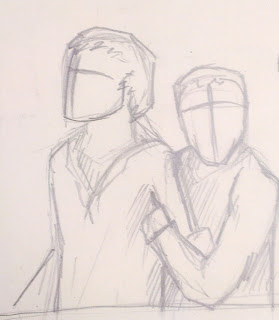As mentioned yesterday for the next three days I'll be preparing for motion capture. I've been looking into exactly what I need to do to prepare and have come across this very handy book which outlines the process for an actual game developer. They use the example of a studio creating roughly 500 motion captures for one actor so it's not quite applicable to me right now but the general method will be useful.
The book is called The game production handbook by Heather Maxwell Chandler and here is the example for the animation list she gives.
Just in case it's not readable... The first collum is the ID number of the shot, the second is the base position that the actor needs to start and finish in the help with blending the animations later on, movement description which is pretty much what it sounds like, length of animation roughly, which character the action is performed by and file name which I'm really glad it included because I wouldn't have thought about that at all.
The book also recommends that I know exactly what I want the actor to do and to be prepared to act it out myself as an example. That's fine, I'm prepared and I'm making rough storyboards or at least notes on each animation to help with this process over the next few days.
IMPORTANT NOTE: Remember to take a photo of the actors in the motion capture suit so they can be used as reference when cleaning up the footage.
BODY LANGUAGE! YES MORE OF THE STUFF!
General body language tips
If a character is enthusiastic they will make bigger gestures especially if they aren't worried about how they are going to come off.. if the NPC is more comfortable around you they will make larger gestures and so the more positive reactions will need to reflect this.
Categories of Non verbal communication according to Blatner, 2009
- Personal space (proxemics (scheflen, 1963))
the space between two people indicates the relationship between them. The close they are the more intimate they are to one another. (Keltner, 1970)
- Eye contact (proxemics (scheflen, 1963))
This is a method people use when they can't keep a comfortable amount of personal space such as a lift environment or a crowded area like a market place. (Scheflen, 1972)
"Modern American business culture values a fair degree of eye contact in interpersonal relations, and looking away is sensed as avoidance or even deviousness." (Blatner, 2009)
"Modern American business culture values a fair degree of eye contact in interpersonal relations, and looking away is sensed as avoidance or even deviousness." (Blatner, 2009)
- Posture (positions provided by blatner, possible meanings, suggested by myself and peers)
slouching - dismissive, bored, uninterested, tired
twisted - wary, uncomfortable, stretching, disgust, defensive
crouching - afraid, hiding, mimicking animals ready to pounce, sneaky,
twisted - wary, uncomfortable, stretching, disgust, defensive
crouching - afraid, hiding, mimicking animals ready to pounce, sneaky,
pelvis tilt - attracted, sassy, confident,
kneeling - submissive, pleading, praying faith related
kneeling - submissive, pleading, praying faith related
stiff - uncomfortable, intimidated, afraid, medical, careful
angled torso - direction of interest, interested, lean back intimidated
shoulders forward - aggressive,
angle of head - direction of interest, curious, confused, thought process related.
towering - dominant, intimidating, authority
legs spread - masculine, dominant, relaxed, provocative (female)
general tightness - uncomfortable, uneasy, tense, not quite scared.
jaw thrust - aggressive, angry, unimpressed, confrontational.
angle of head - direction of interest, curious, confused, thought process related.
towering - dominant, intimidating, authority
legs spread - masculine, dominant, relaxed, provocative (female)
general tightness - uncomfortable, uneasy, tense, not quite scared.
jaw thrust - aggressive, angry, unimpressed, confrontational.
- Facial expression
The expression the face shows can be affected by the particular environment the individual is brought up in. For example if someone is brought up in the sun they will squint more which could be mistake as a visual cue for happiness.
- Gestures (list provided by blatner, meanings provided by myself and peers)
clenching fists - anger, frustration
biting fingernails - scared, nervous
rubbing chin- curious, thinking
raising eyebrows - surprise, confused, interest, fear
scratching head - confused, curious, thinking
hands behind head - relaxed, confident
sticking out tongue - cheeky, rude, silly, young, immature
shaking a finger - disapproving, authority, trying to remember something, making a point
tugging at hair - frustrated, thinking,
smoothing hair - preening, relaxed, flirty, nervous, self conscious
pursing lips - vain, annoyed, flirty,
looking away - dismissive, nervous, shy, intimidated
rubbing nose - lying, irritated
tugging earlobe - flirtatious, lying, nervous
pointing - rude, argumentative, giving directions, thinking
squirming - uncomfortable, scared,
folding arms - defensive, disappointing, fed up, confident, assertive, uncomfortable
narrowing eyes - aggressive, skeptical, suspicious
hands on hips - confident, flirty,
rocking - scared, mentally unstable, reassuring self
- Inappropriate action (put bucket on head)
Annoyed-Confused-Sarcastic?
- Destruction/Theft
One final thing for today (sorry this post has been so mismatched and stuff) i've made a start on the chart for the final interactions. I'll post it tomorrow when it's done and possibly a changed one which shows any which would make more sense to be hand animated but im not sure many will be.





No comments:
Post a Comment